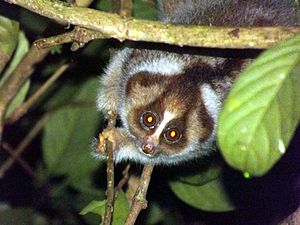Kayan Slow Lory
| Kayan Slow Lory | ||||||||||||
|---|---|---|---|---|---|---|---|---|---|---|---|---|

Kayan's slow lorikeet ( Nycticebus kayan ) |
||||||||||||
| Systematics | ||||||||||||
|
||||||||||||
| Scientific name | ||||||||||||
| Nycticebus kayan | ||||||||||||
| Munds & Nekaris , 2013 |
The Kayan's slow lorikeet ( Nycticebus kayan ) is a wet-nosed primate of the genus slow loris that is common on the island of Borneo . N. kayan was only identified as a separate species in late 2012. It has the very unusual property of mammals to have a venomous bite.
description
The Kayan Plumplum Lorikeet has a dark, very high-contrast face mask with black rings around the eyes. The specimens examined were about 27 cm tall and weighed about 410 g. The face mask is rounded or pointed over the eyes with distinct edges. With other slow loris from Borneo, this area is never pointed and rounded areas are blurred or at least frayed. Compared to the Philippines' slow lorikeet , the fur is longer and fluffier.
Like other slow loris, the kayan slow loris has a rudimentary tail, round head, short ears, a toothed comb, and an arched cleaning claw that is used for grooming. The Kayan slow lorikeet is nocturnal and lives in small groups on trees. Similar to the water shrew or the slit weevil , the kayan slowlory has a poisonous bite and is one of the very rare representatives of poisonous mammals . The poison is absorbed by licking a gland on the arm and mixed with the saliva. The poison can repel enemies and is rubbed into the fur of the young animals when grooming . When attacked, the Kayan Slow Lory licks its arm glands and inflicts poisonous wounds on its enemies. The slow loris are probably immune to their own poison.
Taxonomy and Distribution
The Kayan slow lorikeet was described in 2012 as a separate species that occurs sympatricly with another species of slow lorikeets ( N. menagensis ) in central and northern Borneo ( Sarawak , Sabah and parts of Kalimantan ) . The species was named after the Kayan , a river that flows through the range.
Individual evidence
- ↑ Pia Heinemann: Species Diversity: Cute plum lorikeets protects itself with body poison . In: THE WORLD . December 16, 2012 ( welt.de [accessed on March 28, 2020]).
- ^ Bryner, Jeanna (December 14, 2012). "Slow Loris Species, Nycticebus Kayan, Discovered In Borneo (PHOTO)". Huff Post Green. Retrieved December 15, 2012.
- ↑ Walker, M. (December 13, 2012). "Primate species: new slow loris found in Borneo". BBC News.
- ^ Alterman, L. (1995). "Toxins and toothcombs: potential allospecific chemical defenses in Nycticebus and Perodicticus". In Alterman, L .; Doyle, GA; Izard, MK Creatures of the Dark: The Nocturnal Prosimians. New York, New York: Plenary Press. pp. 413-424. ISBN 978-0-306-45183-6 . OCLC 33441731
- ^ Bryner, Jeanna (December 14, 2012). "Slow Loris Species, Nycticebus Kayan, Discovered In Borneo (PHOTO)". Huff Post Green. Retrieved December 15, 2012.
literature
- Rachel A. Munds, KAI Nekaris & Susan M. Ford: Taxonomy of the Bornean Slow Loris, With New Species Nycticebus kayan (Primates, Lorisidae). American Journal of Primatology 75: 46-56 (2013) doi : 10.1002 / ajp.22071 , PDF